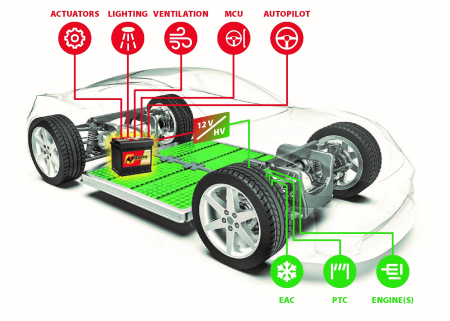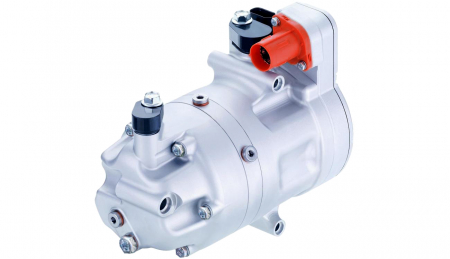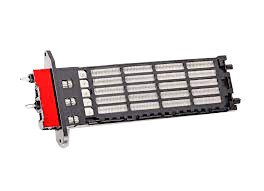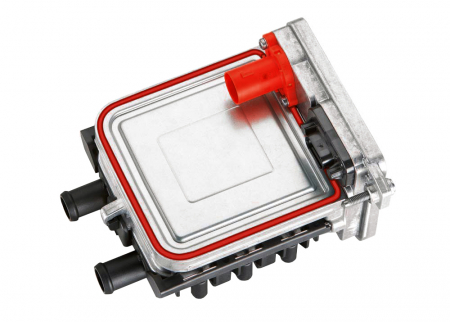E-MOBILITY
BASIC KNOWLEDGE OF ENERGY AND THERMAL MANAGEMENT
Of course, many additional electrical consumers in electric and hybrid cars also work with 12V voltage
(e.g. audio, autopilot and safety systems, all motors that are not part of the drive - power windows, windscreen wipers, side mirrors, power steering, seat motors, ...; also headlights, interior lights, instrument cluster including main display, ...).
These have been optimised over decades and are used in millions of new cars every year (combustion engines and electric or hybrid cars).
It is clear that no e-car manufacturer wants to develop them anew, especially since they all do not need too much power.

12V power supply - a main task of the on-board battery.
The 12V on-board network is therefore also set for vehicles with electric and hybrid drives. At present, stability, availability and the lower risk mean that a lead-acid-based battery is installed in almost all electric and hybrid cars for the 12V electrical system.
The reason for a separate 12V vehicle electrical system battery is to supply critical systems in the event of an interruption to the high-voltage battery or a technical problem with the voltage converter. This means that airbags, brake boosters, belt tensioners, emergency flashers, central locking and a variety of other systems remain operational. The high-voltage battery can be switched off by various rare events, e.g. a violent collision, internal problems with the high-voltage battery (e.g. certain types of cell faults), a contactor fault and some other unlikely situations.
From the mechanics scene, the reference to high-voltage power consumers comes up frequently.
Yes, they do exist and are supplied with power directly from the high-voltage battery. As a result of our research, here is a list without any claim to completeness.

High-voltage air conditioning compressor
This guarantees vehicle air conditioning even when the engine is switched off. This is because the refrigerant must first be compressed in order to be able to expand later. The coolant is then also cooled down by the air conditioning system and outside air is only supplied when required (EAC = Electronic Air Control).
Furthermore, the cooling of the high-voltage battery - to which the air conditioning system often contributes directly or indirectly - must be permanently ensured. In more and more car models (full-hybrid, plug-in-hybrid and electric), it is possible to cool down the passenger compartment before the journey starts by activating the air conditioning compressor with a remote control if the system is designed accordingly.
Good to know! In electric cars, the air conditioning system is not only an important comfort feature for passengers. It also ensures the high-voltage battery's "comfortable temperature," which is crucial for full performance and a long service life of the drive battery.
PS: A conventional air conditioning compressor could be installed in hybrid vehicles, but then the passengers would have to manage without interior cooling in purely electric driving mode. Well, who wants that nowadays?!

High-voltage interior auxiliary heater
The basic principle is familiar from the electric fan heater at home. With electric direct heating, the air is heated by electric heating coils and then released into the passenger compartment via the ventilation system. This is because electric drives, due to their high efficiency, emit only little heat loss to the environment; the waste heat (heat loss) of a combustion engine for heating purposes is missing!
This is why the future development is moving away from parking heaters towards driving heaters.

High-voltage coolant auxiliary heater
If the temperature is too low, the coolant is heated by an electric high-voltage auxiliary heater. This is placed directly in the cooling circuit. When the heater is switched on, current flows from the high-voltage battery - not the 12V on-board battery - to the heater and heats the auxiliary heater. At the same time, the circulation pump of the water circuit switches on and pumps water through the heater.
Also known as a PTC auxiliary heater, a PTC or semiconductor is a ceramic-based electrical component with temperature-dependent resistance that is used as a heating element. Its positive temperature coefficient (PTC = Positive Temperature Coefficient) allows current to flow better at low temperatures than at high temperatures.
PS: Then there is sometimes a bioethanol-powered heater for continuous heating in e-cars. This is because air conditioning the passenger compartment can require a lot of energy. If this were done electrically in the case of heating, the additional power requirement could reduce the vehicle's range by up to 30 per cent! Conversely, the bioethanol heater is therefore a decisive range extender for electric cars.
Only a few other components are also supplied directly from the high-voltage battery. These include the traction motor(s) and the DC/DC converter for 12V current and charging the 12V on-board battery (DC = Direct Current).
As there is no uniform standardised battery voltage for electric and hybrid vehicles to date, the high-voltage power consumers are often designed in such a way that application in ranges between approx. 250 and 450V is possible without loss of power - with an efficiency of up to 99%!
Let's talk about the wording and avoid any confusion of terms.
The on-board battery is also colloquially referred to as an auxiliary, backup, low-voltage, support, additional or secondary battery.
In terms of wording, the lithium-ion drive battery is also known as a high-voltage battery (HV = High Voltage).
Acuators = e.g. lighting systems and electric motors do the opposite of sensors. Conversion of current or voltage into another form of energy such as light, torque, motion, temperature, pressure, sound, ...
DC = Direct Current, i.e. direct voltage.
EAC = Electronic Air Control; in electric cars, energy can be saved by the air conditioning system only supplying outside air when required. The air conditioning compressor also enables vehicle air conditioning even when the engine is switched off.
HV = High Voltage
MCU = Media Control Unit, the term describes the hardware behind the infotainment system - primarily microprocessors that receive information from a large number of sensors, but also memory chips and other electronic components.
MCU = Micro Controller Unit, is generally an integrated circuit in electrical engineering that controls device processes and certain systems.
MCU = Motor Control Unit, is a component known as an inverter, also known as a phase converter, resonant converter, converter or inverter.
PTC = Positive Temperature Coefficient, is a ceramic-based electrical component with temperature-dependent resistance, which is used as a heating element in the coolant auxiliary heater. Its positive temperature coefficient (PTC) allows the current to flow better at low temperatures than at high temperatures.
More articles on this topic

